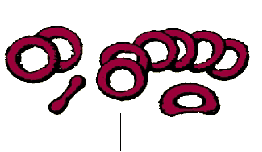|
PinkMonkey Online Study Guide-Biology
Functions of plasma: Plasma is the chief transporting medium supplying water, Oxygen and metabolites to all cells and also collects nitrogenous waste products and Carbon Dioxide from them.
(B) Blood corpuscles: These are blood cells suspended
in plasma and are of three types, namely, erythrocytes, leucocytes and
blood platelets.

Red blood corpuscles
Figure 18.9 Human red blood
corpuscles
(1) Red blood cells (corpuscles) or Erythrocytes
Red blood cells or erythrocytes are red
in color and are numerous, about five million per cubic millimeter; hence
they give the red color to blood. They are circular biconcave, anucleate
(without a nucleus) and immobile. Being flexible, they get twisted
and can be squeezed through blood capillaries smaller than their diameter.
Each red blood cell shows the central spongy mass called stroma
containing a red colored substance called hemoglobin which is the
respiratory pigment. Hemoglobin readily combines with oxygen to
form an unstable compound known as oxyhemoglobin.
Hemoglobin + Oxygen.  Oxyhemoglobin Oxyhemoglobin
Hence red blood cells are called oxygen carriers.
The red blood cells of human beings are short-lived, having about 100
to 120 days of normal life span, probably because of the absence of a
nucleus. They are produced in the red bone marrow and when dead they are
constantly disintegrated in the liver and spleen.
Hemoglobin contains iron atoms involved in binding oxygen; thus
liver is a good dietary source of iron.
[next page]
|
Table of Contents
Table of Contents
18.0 -
Introduction
18.1 -
Closed Vascular System
18.2 -
Heart
18.3 -
Arterial Blood Pressure
18.4 -
Blood
Chapter
19
|